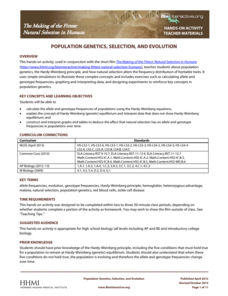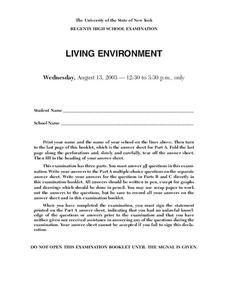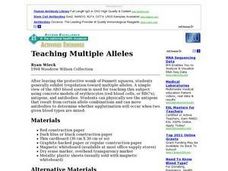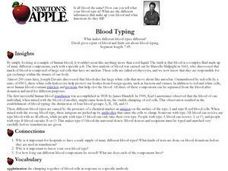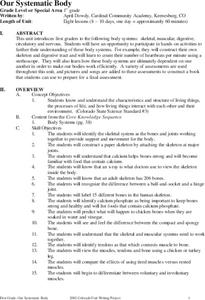Nemours KidsHealth
Human Body Series: Immune System
When you work with school children, teaching about immunity and illness prevention is a priority! This approach includes a discussion, kid-friendly online articles, a creative writing assignment, and a quiz on the role of leukocytes and...
Howard Hughes Medical Institute
Population Genetics, Selection, and Evolution
The Hardy-Weinberg principle states that alleles and genotypes remain constant in the absence of evolutionary influences. Scholars complete a simple hands-on activity applying the Hardy-Weinberg principle to sample data. They observe how...
Baylor College
Modeling an HIV Particle
Models are an important part of science; they help us see the world on a scale that works for us. In the first of five lessons on HIV, learners make a paper model of the HIV virus that is about 500,000 times larger than the actual virus....
Curated OER
Infection Wars
Students observe blood cells under a microscope and make drawings of their observations. They write and act out a short play starring blood cells, antibodies and bacteria to demonstrate fighting infection.
Curated OER
Your Body's Defenses When Microbes Attack
Young scholars study how being exposed to a harmful microbe doesn't automatically make them ill. They discover the lines of defense against microbe invaders and explore the roles of skin and mucus membranes, white blood cells, and...
Curated OER
Blood Types
In this algebra worksheet, students examine the 4 different blood types, and make a graph deciding which blood types are compatible with each other when it comes to donors. There are 9 questions with an answer key.
Curated OER
Living Environment
In this environmental lesson students complete a series of multiple choice and short answer questions on animal populations, cell structure and chromosomes.
Curated OER
Introduction to the Circulatory System
Fifth graders study the circulatory system. In this circulatory system, 5th graders participate in five stations with different activities at each station. Students discuss their findings from each station.
K12 Reader
Tissues, Organs and Systems
Young scientists are introduced to the connections among cells, tissues, organs, and systems in a life science reading comprehension worksheet that asks them to respond to a series of questions based on the passage.
Curated OER
ESL/EFL Lesson Plan - Longevity Blood Tests - By Sean Banville
Students read the article Blood Test Predicts When You'll Die. In this reading comprehension lesson, students read the article and complete a variety of activities. They work individually and in pairs to complete questions dealing with...
Curated OER
Bones: Reading and Quiz
Make no bones about it- this anatomy instructional activity is all about the human skeleton! Learners read a 2-page informational excerpt on bones and then use the information they learned to answer 9 recall questions, including 4...
Curated OER
Pre-Hardy-Weinberg
Students examine the inheritance of ABO blood groups. In this investigative instructional activity students perform a lab and show how natural selection can alter the gene frequencies in a population.
Curated OER
Fighting Infection
Students study immune responses and the structures that are related to immune cells functions. In this fighting infection activity students construct antibody complexes and model the interaction of the immune system when it is...
Curated OER
Review for Strand 2A Test: Nervous System
Three pages containing 51 true and false questions make up this nervous system review. The major topics listed at the top of the test mention a film strip and a laboratory activity, but the questions appear to be answerable without...
Curated OER
Born of Blood
Young scholars define attributes of human chromosomes and match them to make a human karyotype. In this investigative lesson students demonstrate how traits are encoded in genes found on chromosomes.
Curated OER
Teaching Multiple Alleles
High schoolers view a simple ABO blood system for the introduction of this subject using concrete models of eythrocytes (red blood cells, or RBC's), antigens, and antibodies. They can physically see the antigens that result from certain...
Curated OER
Tag, You're Sick
Young scholars play a game to model how the immune system works. In this health and wellness lesson, the teacher explains how the immune system works, then students play a game of tag trying to stay away from germs, viruses, and...
Curated OER
How Does the Cardiovascular System Work?
Students explore the basic anatomy and functions of the cardiovascular system. They identify parts of the cardiovascular system according to the levels of organization. In addition, they trace the path of a blood cell through the...
Curated OER
Totally Cellular
For this biology worksheet, students learn about cells and their various parts. They first read a page and a half of facts about cells and then answer the 10 questions in the packet. The answers are on the last page.
Curated OER
What's Your Type
Students record their blood types on a class graph and calculate the potential number of blood donors for each group.
Curated OER
Use of Microscopes and Creation of Slides
Learners explore the use of microscopes and the creation of slides. They practice using, adjusting and viewing with a microscope. they view slides of familiar substances such as blood and fibers. In addition, they create slides using...
Curated OER
PBS - Scientific American Frontier:Affairs of the Heart:Teaching Guide:Exploring Vessel Physics
Students explore the relationship between pressure and vessel diameter. They are given an open-ended design challenge in which they engineer their own remote repair device. Students see a model that represents how elevated blood...
Curated OER
Elastic Recoil in Arteries and Veins
A lab in which high schoolers examine the difference between arteries and veins. Budding biologists will find out which blood vessel can stretch furthest, recording their data in a table then answering several questions evaluating their...
Curated OER
Our Systematic Body
Students explore several parts of the body system in the eight lessons of this unit. Through several hands-on activities, the skeletal, muscular, digestive, circulatory and nervous systems are observed.



